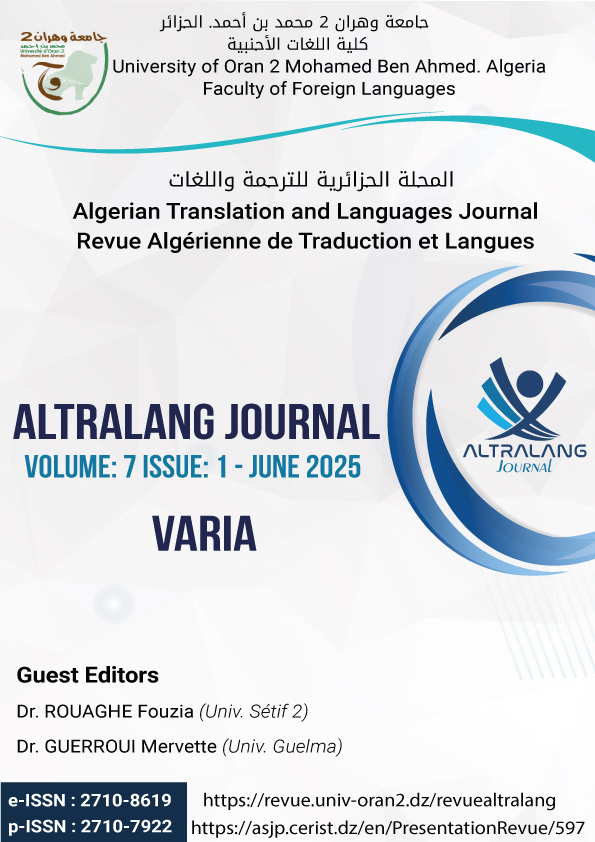Semantic Memory in Arabic-Speaking Children with Language Delays
Main Article Content
Abstract
This study involves a linguistic-cognitive approach to language delay (LD) by revealing the process of semantic memory (SM) in the Arabic-speaking child according to the specificity of the Arabic language. The study aimed to answer a fundamental question about the contribution of the correlation between SM and LD in Arabic-speaking children. A sample of 32 children with LD was based on an experimental approach, including language, SM, and mental abilities tests. The results of the study found that understanding the nature of LD comes from understanding its relation to SM. We explain language impairment as a disorder in the SM processes that appear in both semantic organization and retrieval, with an advantage for retrieval. The specificity of the Arabic language in its derivation, richness, and morphological structure contributed to increasing the level of lexical access and thus the richness of the mental lexicon, and from it, the processing of language knowledge at the level of SM varies according to the features of the language.
Article Details

This work is licensed under a Creative Commons Attribution 4.0 International License.
LICENSE: This work is licensed under a Creative Commons CC BY 4.0 license
References
• Baddeley, A (1993). human memory, theory and practice, trans., under the direction of Solange Hollard, Presses universitaire de Grenoble.
• Baddeley A, D(1994): human memory, in research review, special issue 267, 1994, PP 730 735.
• Boukhari, S. (2002). Semantic memory in people with dysgraphia in an Algerian clinical environment, a cognitive-linguistic approach. these. University of Algeria.
• Bruner, J, S. (1993). Child development: knowing how to do, knowing how to say. Ed, Phew, Paris. 4th edition.
• Chevrie-Muller, Claude. Simon, A, M. Fournier, S. (1997). Oral and written language battery, memory, attention (L2MA). ECPA. Paris.
• Drivel, Y. (2007). A study of semantic memory in people with Down syndrome. These. University of Algeria.
• Jomaa, S, Y.(2002). Language Comprehension and Production Test Battery, Anglo-Egyptian Library.Cairo.
• Haj Saleh, A, R. (2007). New Khalilian theory. Brochures from the Scientific and Technical Research Center for the Development of the Arabic Language in Algeria. Fourth issue, Dar Homa, Algeria.
• Hamdash, M (2002). Semantic memory in a person with Broca’s aphasia. These. University of Algeria.
• Iaatidal, A (2012).Study of semantic memory and verbal linguistic ability in mentally disabled children. A case of Down Syndrome. These. University of Algeria.
• Gasmi, A. (2002). Working memory and its relationship with vocabulary acquisition: a comparative study between normal children and children suffering from a mild linguistic disorder. These. University of Algeria.
• Mazeau, M. (1999). Les troubles mnésiques : Implication en langage oral et langage écrit. In bulletin d'audiophonologie, Vol XV, N°2, 1999, pp 201-222.
• Naglieri, J, A. (1998). NNAT Naglieri Non-Verbal Aptitude Test, Ecpa. France.
• Nouani, H. (2012). Language disorders and associated cognitive activities, “example of working memory”. Cognitive Research Journal: University of Fez, Morocco.
• Piaget, J (1976). Language and thought in children. Ed. Delachaux and Niestlé 9th edition. Paris.
• Tulving, E (1983). Elements of episodic memory. Oxford University Press. New York.
• Vygotsky, L. (1997). Thought and language. Ed, ADAGP, 3rd edition, Paris.
• Warrington, E. (1975). The selective impairment of semantic memory. Quarterly Journal of Experimental Psychology, 27, 635-657.
• Zegboush, B. (2008). Memory and language: a cognitive psychology approach to lexical memory and its pedagogical extensions. Modern Book World.1st Ed .Amman.
• Zegboush, B. (2013).The effect of the specificity of the Arabic language on access to lexical memory, Journal of psychological and educational studies, number 10, Department of psychology, educational sciences and speech therapy. University of Algiers.

1.png)